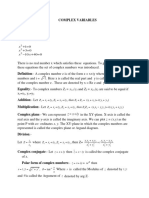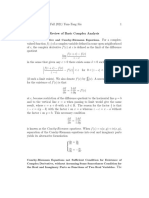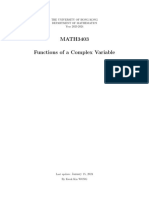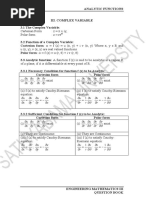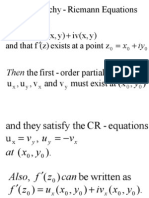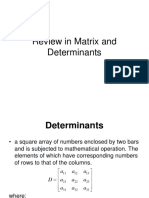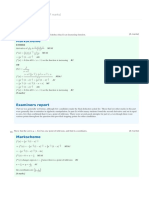VTU M4 Unit3
Uploaded by
MurthyVTU M4 Unit3
Uploaded by
Murthyvtu.allsyllabus.
com
www.allsyllabus.com
Unit_III
Complex Numbers:
In the system of real numbers R we can solve all quadratic equations of the
form
ax 2 + bx + c = 0 , a 0 , and the discriminant b 2 4ac 0 . When the discriminant
b 2 4ac < 0 , the solution of this quadratic equation do not belong to the
system of .
In fact , a simple quadratic equation of the form x 2 + 1 = 0 , does possesses
solution in real. This difficulty was overcame by introducing the imaginary
part unit i, where i 2 = 1 .
Thus the set of complex numbers defined as . C = {( x + iy ) : x, y R and i = 1 } .
co
Some Basic Results:
bu
s.
1. If z = x +iy is a complex number, then the complex number z = x iy is
called the complex conjugate of z , and z z = ( x + iy )( x iy ) = x 2 + y 2
2.If z= x+iy is a complex number , then the modulus of z, denoted by
z = x2 + y2
.a
l
ls
yl
la
3. A complex number z = x + iy is represented by a point p(x ,y) in the
Cartesian plane with abscissa x and ordinate y. Then the x-axis is called real
axis and the y-axis is called the imaginary axis.The point p(x, y) is referred
to as the point z.
Let OP= r and XOP = . Then x = r cos , y = rsin
Every Complex number can z = x +iy be expressed in the form as given
below
z = r(cos + isin )
polar form
z = rei
exponential form
We observe that r = x + y the modulus of z and it represents the
distance of the point z from the origin. Also
y
= tan -1 the angle is called the arg ument of z.
x
4. Let z 0 = x 0 + iy 0 then z - z 0 = ( x x0 ) + i( y y 0 )
( x x 0 ) 2 + ( y y 0 )2 .
Now z - z 0 may be represented as
www.allsyllabus.com
vtu.allsyllabus.com
www.allsyllabus.com
and z z 0 = R serves as the complex equation
of the circle C with (x0 , y 0 ) and radius R. In particular z = 1 represents the
circle with center at the origin and radius equal to 1.
z - z 0 = R (cos + i sin )
Functions of a complex variable:
Let C be a set complex numbers. If to each complex number z in C there
corresponds a unique complex number w ., then w is called a complex
function of z defined on C, and we write w = f(z). Hence ,w has a real part ,
say u and an imaginary part , say v. Then , w has the representation
W= f(z) = u(x,y) + i v(x,y) (Cartesian form)
W = u(r,) + i v(r,)
(polar form)
is defined at z 0 and
lim f(z) = z
z z 0
co
m
Continuity :
A complex valued function f(z) is said to be continuous at a point z 0 if f(z)
.
lls
yl
la
bu
s.
Note:
1. If a complex valued function f(z) is differentiable at a point z 0 , then
it is continuous at z 0 .
2. The converse of the above result is not always true. The continuity of
a complex function need not imply its differentiability.
Derivative of a complex function:
.a
The derivative of a complex function f at a point z = z 0 , denoted by f (z 0 ),
f(z + z ) f(z 0 )
, provided this limit exists.
is defined as f 1 ( z 0 ) = lim 0
z 0
z
Substituting z = z - z 0 , we have
f(z) f(z 0 )
z 0
z
We should remember that by the definition of limit f(z) is defined in a
neighborhood of z 0 and z may approach z 0 from any direction in the
complex plane . The derivative of a function at a point is unique if it exists.
Analytic Functions. Cauchy-Riemann equations.
In complex analysis we are interested in the functions, which are
differentiable in some domain, called the analytic functions. A large variety
of functions of complex variables which are useful for applications purpose
are analytic.
f 1 ( z 0 ) = lim
www.allsyllabus.com
vtu.allsyllabus.com
www.allsyllabus.com
A Function f(z) is said to be analytic at a point z 0 , if it is differentiable
at z 0 and, in addition , it is differentiable throughout some
neighborhood of z 0 .
Further a function f(z) is said to be analytic in a domain D if f(z) is defined
and differentiable at all points of D. In fact , analyticity is a global
property while differentiability is a local property.
The terms regular and holomorphic are also used in place of analytic.
Cauchy-Riemann Equations :
and u = v
. At the point z = x + iy.
bu
u = v
s.
co
Cauchy Riemann equations provide a criterion for the analyticity of a
complex function W = f(z) = u(x,y) + i v(x,y) .
Statement: Necessary conditions for a function to be analytic.:
If f(z) = u(x,y) + i v(x,y) is continuous in some neighborhood of a point
z= x+ iy and is differentiable at z , then the first order partial derivatives of
u(x,y) and v(x,y) exist and satisfy the Cauchy-Riemann equations
y
z 0
x + iy
--------(I)
z 0
{ u ( x + x, y + y) + i v (x + x, y + y) } {u (x.y) + i v(x, y) }
f 1 ( z ) = lim
f(z + z ) f(z)
z
w
.a
f ( z ) = lim
lls
yl
la
Proof:
Since f(z) is differentiable at z, we have
Let us assume z to wholly real and wholly imaginary.
Case I: When z wholly real, then y = 0 , so that z = x .The limit on
the right side of equation (I) becomes,
f 1 ( z ) = lim
x 0
{ u ( x + x, y) x
u(x.y) }
+ i lim
z 0
{v( x + x, y) -
v(x.y) }
u
v
+i
.
--------------------------------------(II)
x
x
Case II: When z wholly imaginary, then x = 0 , so that z = iy .The
=
limit on the right side of equation (I) becomes,
www.allsyllabus.com
vtu.allsyllabus.com
www.allsyllabus.com
f 1 ( z ) = lim
{ u ( x, y + y) iy
y 0
u(x.y) }
1 u v
+
i y y
+ i lim
y 0
v u
i
y y
{v( x, y + y) -
v(x.y) }
iy
---------------------------------------(III)
Since f(z) is differentiable the value of the limits obtained from (II) and (III)
must be equal.
u
v
+i
=
x
x
v u
i
y y
Comparing the real and imaginary parts, we get
co
m
u
v
u
v
at the z = (x,y).
=
and
=
x
y
y
x
la
bu
s.
These are known as the Cauchy-Riemann equations. Satisfaction of these
equations is necessary for differentiability and analyticity of the function f(z)
at a given point. Thus, if a function f(z) does not satisfy the CauchyRiemann equations at a point, it is not differentiable and hence not analytic
at that point.
dw
, and determine where w is not analytic.
dz
Let us consider z in exponential form , z = re i = r (cos + i sin )
y
r = (x 2 + y 2 ) , = tan 1
x
w = u + iv = log(x + iy)
1
y
= log(x 2 + y 2 ) + i tan -1
2
x
.a
l
ls
yl
Ex 1: If w= logz, find
Equating real and imaginary parts
1
y
log(x 2 + y 2 ) : v = tan -1
2
x
u
x
v
y
= 2
:
= 2
2
x
x +y
x
x + y2
u=
u
y
= 2
y
x + y2
v
x
= 2
y x + y 2
www.allsyllabus.com
vtu.allsyllabus.com
www.allsyllabus.com
Now from- C-R equations
u
v
=
x
y
and
u
v
=
y
x
Thus w = logz the C-R equations holds good for (x 2 + y 2 ) 0
Further ,
dw u
dv
x
y
=
+i
= 2
i
dz x
dx (x + y 2 )
x 2 + y2
x - iy
z
1
dw
= 2
=
=
x + y2
z
dz
z (z )
()
co
Thus every point other than origin ( i.e. x 2 + y 2 0 ) w=logz is
differentiable and the function logz is analytic every where except at origin.
bu
s.
Ex2: Show that the function w= sinz is analytic and find the derivative.
lls
yl
la
w = u + iv = sin(x + iy)
= sinx cosiy + cosx siniy ------------------------(1)
e ix e ix
e ix e -ix
and cosx =
Now sin x =
2i
2
sinix = isinhx : cosix = coshx
w
.a
Using these in equation (1)
W = (u + iv ) = sinx coshy + icosx sinhy
Equating real and imaginary parts, we get
u = sinx coshy : v= cosx sinhy
u
v
= cosx coshy ,
= sin x sinh y
x
x
-------------------------(2)
u
v
= sinx sinhy ,
= cosx coshy
y
y
The C-R equations are satisfied
u
v
=
x
y
and
u
v
=
y
x
f(z) = sinz is analytic.
u
dv
+i
= cosx coshy + i(- sinx ) sinh y
x
dx
= cosx cosiy sinx sin iy
f 1 (z ) =
www.allsyllabus.com
vtu.allsyllabus.com
www.allsyllabus.com
= cos(x + iy ) = cosz
Consequences of C-R Equations:
1). If f(z)= u + iv is an analytic function then u and v both satisfy the two
dimensional Laplace equation.
2 2
+ 2 = 0 This equation is also written as 2 = 0 .
2
x
y
Here 2 is the two- dimensional Laplacian.
Since f(z) is analytic we have Cauchy-Riemann equations
(I )
and
u
v
=
y
x
( II )
u
v
=
x
y
2u
2v
and
=
y 2
y x
bu
s.
2u
2v
=
x 2
x y
co
Differentiating (I) w,r,t. x and (II) w.r.t y partially we get
w
w
.a
lls
yl
la
2v
2v
=
is always true and hence we have
But
x y
y x
2u
2u
2u
2u
+
= 0 ,this implies u is harmonic.
= 2
or
x 2
y 2
x 2
y
Similarly Differentiating (I) w.r.t . y and (II) w.r.t.y partially we get
2v
2v
= 2
x 2
y
2v
2v
= 0 , this implies v harmonic.
or 2 +
x
y 2
If f(z) = u + iv is an analytic function, then u and v are harmonic
functions. Here , u and v are called harmonic conjugates of each other.
Consequence II:
If f(z) = u + iv is an analytic function, then the equations u ( x, y ) = c1
And v( x, y ) = c 2 represent orthogonal families of curves.
Soln:
u (x, y ) = c1 -------------(i)
v(x, y ) = c 2 --------------(ii)
Differentiating eqn (i) partially w.r.t x
www.allsyllabus.com
vtu.allsyllabus.com
www.allsyllabus.com
u
dy
x = m --------- (I)
or
=
1
dx
u
y
u u dy
+
=0
x y dx
Differentiating eqn (ii) partially w.r.t. x
v
dy
x = m ---------(II)
or
=
2
dx
v
y
The two families are orthogonal to each other , then m1m 2 = 1 ,
And using C-R equations
(u x )(v x ) = (v y )( u y ) = 1
(u y )(v y ) (u y )(v y )
bu
s.
m 1m 2 =
co
m
v v dy
+
=0
x y dx
la
Hence the curves intersect orthogonally at every point of intersection.
x 2 + 2y 2 = c 2
x2
= c1 :
y
.a
lls
yl
Note: The converse of the above result is not true. The following example
reveals the property.
x2
u=
:
v = x 2 + 2y 2
y
u
dy
x = (2x y ) = 2y = m for curve c
=
1
1
(- x 2 y 2 ) x
dx
u
y
v
dy
x = (2x ) = x = m for curve c
=
2
2
(4y ) 2y
dx
v
y
m1m 2 = 1 . They intersect orthogonally.
But C-R Equations are not satisfied
www.allsyllabus.com
vtu.allsyllabus.com
www.allsyllabus.com
u
v
x
y
u
v
y
x
and
Some different forms of C-R Equations:
If w = f(z) = u+ iv , is analytic , then the following results follows.
1. f 1 ( z ) =
u
v
+i
=
x
x
u
v
v u
= i + i
i
y
y y
y
u
v
u
v
= i + i
+i
y
x
x
y
w
w
= i
x
y
2
2
2
2
2
u v 1 2 u v
1
f (z ) = + f (z ) = +
x x
x x
la
2.
bu
s.
co
m
u u v u
= + = +
x y x y
2
using C-R Equations.
lls
yl
.a
Based on the results above mentioned the following results are valid,
2
1
(
)
(
)
f
z
(
)
+
f
z
=
f
z
a)
b) is any differential function of x and y then
2
2
1
=
+
+
= f (z ) .
x y u v
2
2
2
2
c) 2 + 2 [Re f (z ) ] = 2 f 1 ( z )
y
x
www.allsyllabus.com
vtu.allsyllabus.com
www.allsyllabus.com
2
2
2
2
d) 2 + 2 f ( z ) = 4 f 1 ( z )
y
x
co
Construction of An Analytic Function When real or
Imaginary part is Given
(Putting in Exact differential M dx + N dy = 0)
The Cauchy-Riemann equations provide a method of constructing
an analytic function f(z) = u+iv when u or v or u v is given.
Suppose u is given, we determine the differential dv , since
v = v(x,y),
v
v
dx + dy using C-R equations ,this becomes
x
y
u
u
dv = dx + dy = M. dx + N dy
y
x
2u
2u
M
=0
= 2 +
And it is clear that
x
y 2
x y
Because u is harmonic. This shows that M dx + N dy is an exact differential.
Consequently , v can be obtained by integrating M w.r.t. x by treating y as a
constant and integrating w.r.t. y only those terms in N that do not contain x,
and adding the results.
Similarly, if v is given then by using
w
.a
lls
yl
la
bu
s.
dv =
v
v
u
u
dx + dy = dx dy .
y
x
x
y
du =
Following the procedure explained above we find u, and hence
f(z) u + iv can be obtained. Analogous procedure is adopted to find
u+iv when u v is given.
Milne-Thomson Method:
An alternative method of finding u iv when u or v or u v
is given.
Suppose we are required to find an analytic function f(z) = u+ iv
when u is given. We recall that
www.allsyllabus.com
vtu.allsyllabus.com
www.allsyllabus.com
u u
f ( z) = i
x y
------------------------(I)
u
u
= ( x, y) and
= ( x, y) -------(II)
x
y
--------(III)
Then f (z) = ( x, y) i ( x, y)
Let us we set
Replacing x by z and y by 0, this becomes
f (z) = (z,0) i (z,0)
-------(IV)
From which the required analytic function f(z) can be got.
Similarly , if v is given we can find the analytic function f(z) = u+ iv by
2
co
s.
starting with
v v
f ( z ) = + i Analogous procedure is used when u v is given.
y x
w
.a
lls
yl
la
bu
Applications to flow problems:
As the real and imaginary parts of an analytic function are the
solutions of the Laplaces equation in two variable. The conjugate functions
provide solutions to a number of field and flow problems.
Let v be the velocity of a two dimensional incompressible fluid with
irrigational motion, V =
v v
i+
j ------------------------------(1)
x y
Since the motion is irrotational curl V= 0.
Hence V can be written as
i+
j -----------------------------(II)
x
y
Therefore , is the velocity component which is called the velocity
potential. From (I) and (II) we have
www.allsyllabus.com
vtu.allsyllabus.com
www.allsyllabus.com
v v
=
,
=
x x y y
------------------------(III)
Since the fluid is incompressible div V = 0.
co
+ = 0 -----------------------(IV)
x x y y
2 2
+
= 0 This indicates that is harmonic.
x 2 y 2
The function (x, y ) is called the velocity potential , and the curves
(x, y ) = c are known as equi -potential lines.
s.
Note : The existence of conjugate harmonic function (x, y ) so that
w
.a
lls
yl
la
bu
w(z) = (x, y ) + i (x, y ) is Analytic.
x
dy
y v y
The slope is Given by
=
=
=
dx
vx
x
y
This shows that the velocity of the fluid particle is along the tangent to the
1
curve (x, y ) = c , the particle moves along the curve.
(x, y ) = c1 - is called stream lines (x, y ) = c - called equipotential
lines. As the equipotential lines and stream lines cut orthogonally.
w(z) = (x, y ) + i (x, y )
dw
=
+i
=
i
dz x
x x
y
= vx vy
www.allsyllabus.com
vtu.allsyllabus.com
www.allsyllabus.com
The magnitude of the fluid velocity
(v
2
x
+ v 2y ) =
dw
dz
The flow pattern is represented by function w(z) known as complex
potential.
Complex potential w(z) can be taken to represent other two-dimensional
problems. (steady flow)
(x, y ) = c --- interpreted as equipotential lines.
(x, y ) = c1 --- interpreted as Lines of force
co
1. In electrostatics
s.
2. In heat flow problems:
la
bu
(x, y ) = c --- Interpreted as Isothermal lines
(x, y ) = c1 --- interpreted as heat flow lines.
lls
yl
Cauchy Riemann equations in polar form:
w
.a
Let f(z) = f(re i ) = u(r, ) + iv(r, ) be analytic at a point z, then
there exists four continuous first order partial derivatives ,
u u v v
,
,
,
and satisfy the equations
r r
u 1 v v
1 u
=
: =
.
,
r r r
r
i
Proof: The function is analytic at a point z = re .
f ( z ) = lim
1
z 0
f(z + z ) f(z) exists and it is unique.
z
Now f(z) = u(r, ) + iv(r, ).
Let z be the increment in z , corresponding increments are
r , in r and .
www.allsyllabus.com
vtu.allsyllabus.com
www.allsyllabus.com
f ( z ) = lim
1
{ u (r + r , + ) + i v (r + r, + ) } {u (r. ) + i v(r, ) }
z
z 0
f ( z ) = lim
1
{ u (r + r, + ) -
u(r. ) }
z 0
{v(r + r, + ) - v(r.) }
+ i lim
z0
------------------------(I)
Now
z = re
z =
z
z
r +
.
r
z =
(re )r + (re )
r
and z is a function two variables r and , then we have
bu
s.
co
z = e r + i r e
When z tends to zero, we have the two following possibilities.
i
f ( z ) = lim
1
w
.a
Z 0 , implies r 0
{ u (r + r, ) -
And
= 0, so that z = e r
lls
(I). Let
yl
la
r 0
u(r. ) }
e r
i
+ i lim
{v(r + r , ) -
r 0
v(r. ) }
e r
The limit exists,
u v
f ( z) = e + i
r
r
-----------------(I)
2. Let r = 0 , so that z = i r e
And z 0, imply 0
f ( z ) = lim
1
{ u (r, + ) i r e
i
u(r. ) }
+ i lim
{v(r, + ) -
z 0
www.allsyllabus.com
ir e
i
v(r. ) }
vtu.allsyllabus.com
www.allsyllabus.com
1
i re
i
v = 1 i u + v
u
+i
i
r e
1 v i u ------------ (II)
f (z) = e
r r
From (I) and(II) we have
1
-i
v
1 u or ru
=
r
r
u 1 v
=
r r
= v , rv = u
r
co
m
Which are the C-R Equations in polar form.
Harmonic Function:
equation
bu
s.
A function -is said to be harmonic function if it satisfies Laplaces
=0
2
.a
lls
1 1
+
+
=0
r r r r
yl
la
Let f(z) = f(re i ) = u(r, ) + iv(r, ) be analytic. We shall show that
u and v satisfy Laplaces equation in polar form.
The C-R equations in polar form are given by,
v
1 u ------------(II)
=
r
r
u 1 v ---------(I)
=
r r
Differentiating (I) w.r.t r and (II) w.r. , partially , we get
v
u
u u
v
: r
=
r
+
=
r
r
r r
And we have v = v
r r
2
www.allsyllabus.com
vtu.allsyllabus.com
www.allsyllabus.com
1 u
u u
r
+
=
r
r
r
2
Dividing by r we, get
u 1 u 1 u
+
+
=0
r
r r r
Hence u-satisfies Laplaces equation in polar form.
The function is harmonic. Similarly v- is harmonic.
2
Orthogonal System:
d
, being the angle between
dr
the radius vector and tangent. The angle between the tangents at
the point of intersection of the curves is 1 2 . Tan Tan = 1,is
the condition for orthogonal.
1
bu
s.
co
Let r = f( ) and tan = r
lls
yl
la
Consider u(r, ) = c1 .
Differentiating w.r.t , treating r as a function of .
u
dr
=
d
u
r
w
w
.a
u dr u
+
=0
r d
Thus Tan = r d
dr
1
= r ( r )
u
(u )
=- r
(u r ) ---------(I)
(u )
Similarly for the curve v(r, ) = c 2
Tan = - r
2
(v r )
(v )
-----------(II)
www.allsyllabus.com
vtu.allsyllabus.com
www.allsyllabus.com
(
r u ) (r v )
r
r
Tan Tan =
(u ) (v )
1
ru = v , rv = u
By C-R Equations
The equation reduces to
v ) (- u )
(
= 1
Tan Tan =
(v ) (u )
2
om
us
.c
Hence the polar family of curves u(r, ) = c1 and v(r, ) = c 2 ,
intersect orthogonally.
lls
yl
la
b
Construction of An Analytic Function When real or
Imaginary part is Given(Polar form.)
The method due to Exact differential and Milne-Thomson is
explained in earlier section .
.a
1
(cos2 ) is harmonic . find also an analytic
r
function.
Soln:
Ex: Verify that u =
u 2
= cos2
r r
: u = 2 sin2
r
u 6
= cos2 :
r
r
2
u
4
=
cos2 .
2
4
r
Then the Laplace equation in polar form is given by,
2
u
1 u
1 u
6
4
2
+
+
=
cos2 cos2 cos2 = 0
r
r
r
r r
r
r
2
www.allsyllabus.com
vtu.allsyllabus.com
www.allsyllabus.com
Hence u-satisfies the laplace equation and hence is harmonic.
Let us find required analytic function f(z) = u+iv.
We note that from the theory of differentials,
dv =
v
v
dr + d
r
Using C-R equations
ru = v , rv = u
r
co
1 u
u
= dr + r d
r
r
2
2
= sin2 dr cos2 d
r
r
bu
s.
= d - sin2
r
lls
From this v = - 1 sin2 + c
r
yl
la
w
.a
1
1
f(z) = u + iv = cos2 + i - sin2 + c
r
r
1
[cos2 - isin2 ] + ic
r
1
e
r
- 2i
+ ic =
1
+ ic
(r e )
i
1
+ ic.
z
Ex 2:Find an analytic function f(z)= u+iv given that
f(z) =
1
v = r - sin
r
r0
www.allsyllabus.com
vtu.allsyllabus.com
www.allsyllabus.com
Soln: v = r + 1 sin
: v = r 1 cos
To find u using the differentials
du =
u
u
dr +
d
r
Using C-R equations
ru = v , rv = u
r
1 v
v
=
dr + - d
r
r
1 1
1
= r - cos dr - r 1 + sin d
r r
r
la
bu
s.
= 1 1 cos dr - r + 1 sin d
r
r
co
lls
w
.a
1
u = r + cos + c
r
yl
= d r + cos
r
f(z) = u+iv
1
1
= r + cos + c + i r - sin
r
r
1
= r(cos + isin + (cos - isin ) + c
r
1
1
f(z) = r e + e = z + + c
r
z
Ex: Construction an analytic function given u = r cos2 .
i
-i
(Milne Thomson Method)
www.allsyllabus.com
vtu.allsyllabus.com
www.allsyllabus.com
u = r cos2 -----------(I)
u
u
= 2r sin2
= 2rcos2
r
2
u v
f ( z) = e + i
r
r
i
Using C-R equations
r u = v , r v = u
r
-1
f (z ) = e 2 rcos2 + i (- 2r sin2 )
r
-i
co
m
= e [2 rcos2 + i (2r sin2 )]
-i
= 2 r e [cos2 + isin2 ]
bu
la
lls
yl
Now put r = z , and = 0 .
f 1 (z ) = 2z on integrating
f (z ) = z 2 + c .
s.
-i
.a
COMPLETION OF UNIT-I
www.allsyllabus.com
www.allsyllabus.com
.a
lls
yl
la
bu
s.
co
vtu.allsyllabus.com
www.allsyllabus.com
You might also like
- Unit - III Complex Numbers:: Re Z 2 2 X R +No ratings yetUnit - III Complex Numbers:: Re Z 2 2 X R +20 pages
- E Math 4 by YRG To Students - Nec - 2078No ratings yetE Math 4 by YRG To Students - Nec - 207815 pages
- 1-Module-1 Complex Variables-21-01-2023No ratings yet1-Module-1 Complex Variables-21-01-202320 pages
- Assignment 4 of M2 (MTH110) - SolutionsNo ratings yetAssignment 4 of M2 (MTH110) - Solutions14 pages
- IB Mathematical Methods II Part 5 of 6 (Cambridge)No ratings yetIB Mathematical Methods II Part 5 of 6 (Cambridge)13 pages
- 1.harmonic Function: 2.properties of Harmonic FunctionsNo ratings yet1.harmonic Function: 2.properties of Harmonic Functions9 pages
- Properties of Real and Imaginary Parts of Holomorphic FunctionsNo ratings yetProperties of Real and Imaginary Parts of Holomorphic Functions4 pages
- Y) IV (X, Y) U (X, F (Z) That Suppose: Equations Riemann - Cauchy: 20 SecNo ratings yetY) IV (X, Y) U (X, F (Z) That Suppose: Equations Riemann - Cauchy: 20 Sec22 pages
- Hyperbolic Functions (Trigonometry) Mathematics E-Book For Public ExamsFrom EverandHyperbolic Functions (Trigonometry) Mathematics E-Book For Public ExamsNo ratings yet
- De Moiver's Theorem (Trigonometry) Mathematics Question BankFrom EverandDe Moiver's Theorem (Trigonometry) Mathematics Question BankNo ratings yet
- Differential Equations (Calculus) Mathematics E-Book For Public ExamsFrom EverandDifferential Equations (Calculus) Mathematics E-Book For Public Exams5/5 (1)
- Executive - Technical A' or B': Walk-In-InterviewNo ratings yetExecutive - Technical A' or B': Walk-In-Interview5 pages
- Sample Paper - 2014 Class - Ix Subject - Science (Chemistry)No ratings yetSample Paper - 2014 Class - Ix Subject - Science (Chemistry)2 pages
- Iti Limited: (A Govt. of India Undertaking)No ratings yetIti Limited: (A Govt. of India Undertaking)5 pages
- David J. Griffiths - Introduction To Electrodynamics - Instructor's Solutions Manual (1999)No ratings yetDavid J. Griffiths - Introduction To Electrodynamics - Instructor's Solutions Manual (1999)250 pages
- Welcome To Our Calculus 1 Subject: Lesson 3No ratings yetWelcome To Our Calculus 1 Subject: Lesson 314 pages
- XII Maths Term 1 Examination 2022-23 SET B QPNo ratings yetXII Maths Term 1 Examination 2022-23 SET B QP4 pages
- Function Spaces Differential Operators and Nonlinear Analysis The Hans Triebel Anniversary Volume 1st Edition Dorothee Haroske - Read the ebook online or download it for the best experience100% (1)Function Spaces Differential Operators and Nonlinear Analysis The Hans Triebel Anniversary Volume 1st Edition Dorothee Haroske - Read the ebook online or download it for the best experience41 pages
- Computation of Dyadic Green's Functions For Electrodynamics in Quasi-Static Approximation With Tensor Conductivity PDFNo ratings yetComputation of Dyadic Green's Functions For Electrodynamics in Quasi-Static Approximation With Tensor Conductivity PDF16 pages
- Unit Iii Analytic Functions Part-A: Problem 1 SolutionNo ratings yetUnit Iii Analytic Functions Part-A: Problem 1 Solution17 pages
- (Undergraduate Texts in Mathematics) Peter J. Olver, Chehrzad Shakiban - Applied Linear Algebra (Instructor's Solution Manual) (Solutions)-Springer (2018)No ratings yet(Undergraduate Texts in Mathematics) Peter J. Olver, Chehrzad Shakiban - Applied Linear Algebra (Instructor's Solution Manual) (Solutions)-Springer (2018)205 pages
- Pauls Online Notes - Linear Algebra - Fundamental SubspacesNo ratings yetPauls Online Notes - Linear Algebra - Fundamental Subspaces9 pages
- MSC 1 Sem Mathematics Numerical Analysis 11170 Summer 2019No ratings yetMSC 1 Sem Mathematics Numerical Analysis 11170 Summer 20192 pages
- IB Mathematical Methods II Part 5 of 6 (Cambridge)IB Mathematical Methods II Part 5 of 6 (Cambridge)
- 1.harmonic Function: 2.properties of Harmonic Functions1.harmonic Function: 2.properties of Harmonic Functions
- Properties of Real and Imaginary Parts of Holomorphic FunctionsProperties of Real and Imaginary Parts of Holomorphic Functions
- Y) IV (X, Y) U (X, F (Z) That Suppose: Equations Riemann - Cauchy: 20 SecY) IV (X, Y) U (X, F (Z) That Suppose: Equations Riemann - Cauchy: 20 Sec
- Hyperbolic Functions (Trigonometry) Mathematics E-Book For Public ExamsFrom EverandHyperbolic Functions (Trigonometry) Mathematics E-Book For Public Exams
- Differentiation (Calculus) Mathematics Question BankFrom EverandDifferentiation (Calculus) Mathematics Question Bank
- Transformation of Axes (Geometry) Mathematics Question BankFrom EverandTransformation of Axes (Geometry) Mathematics Question Bank
- De Moiver's Theorem (Trigonometry) Mathematics Question BankFrom EverandDe Moiver's Theorem (Trigonometry) Mathematics Question Bank
- Differential Equations (Calculus) Mathematics E-Book For Public ExamsFrom EverandDifferential Equations (Calculus) Mathematics E-Book For Public Exams
- Sample Paper - 2014 Class - Ix Subject - Science (Chemistry)Sample Paper - 2014 Class - Ix Subject - Science (Chemistry)
- David J. Griffiths - Introduction To Electrodynamics - Instructor's Solutions Manual (1999)David J. Griffiths - Introduction To Electrodynamics - Instructor's Solutions Manual (1999)
- Function Spaces Differential Operators and Nonlinear Analysis The Hans Triebel Anniversary Volume 1st Edition Dorothee Haroske - Read the ebook online or download it for the best experienceFunction Spaces Differential Operators and Nonlinear Analysis The Hans Triebel Anniversary Volume 1st Edition Dorothee Haroske - Read the ebook online or download it for the best experience
- Computation of Dyadic Green's Functions For Electrodynamics in Quasi-Static Approximation With Tensor Conductivity PDFComputation of Dyadic Green's Functions For Electrodynamics in Quasi-Static Approximation With Tensor Conductivity PDF
- Unit Iii Analytic Functions Part-A: Problem 1 SolutionUnit Iii Analytic Functions Part-A: Problem 1 Solution
- (Undergraduate Texts in Mathematics) Peter J. Olver, Chehrzad Shakiban - Applied Linear Algebra (Instructor's Solution Manual) (Solutions)-Springer (2018)(Undergraduate Texts in Mathematics) Peter J. Olver, Chehrzad Shakiban - Applied Linear Algebra (Instructor's Solution Manual) (Solutions)-Springer (2018)
- Pauls Online Notes - Linear Algebra - Fundamental SubspacesPauls Online Notes - Linear Algebra - Fundamental Subspaces
- MSC 1 Sem Mathematics Numerical Analysis 11170 Summer 2019MSC 1 Sem Mathematics Numerical Analysis 11170 Summer 2019


















